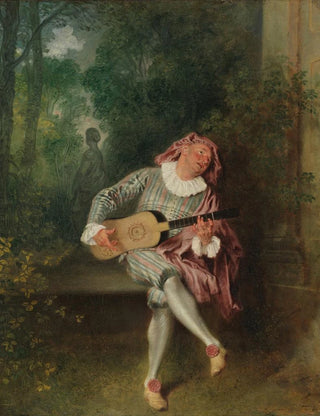Art print | Mezzetín - Jean-Antoine Watteau


View from behind

Frame (optional)
Mezzetín Art print - Jean-Antoine Watteau – Engaging Introduction
In the world of art, certain works transcend time and space, captivating the imagination of viewers across centuries. The Mezzetín by Jean-Antoine Watteau is undoubtedly one of these iconic creations. Painted in the early 18th century, this painting embodies the very essence of rococo, an artistic movement that celebrates lightness, grace, and refinement. Delving into this pictorial universe reveals a world where beauty intertwines with melancholy, where everyday life is adorned with poetic nuances. The art print of this masterpiece offers a gateway to a bygone era, allowing appreciation of the finesse and delicacy of French art at its peak.
Style and uniqueness of the work
The Mezzetín stands out for its delicate style and harmonious compositions. The scene depicts a character in a posture that is both elegant and nonchalant, dressed in a flamboyant costume that immediately draws the eye. Watteau, master of color and light, employs soft tones and subtle contrasts to create an atmosphere that is both intimate and festive. The meticulous details, from the folds of clothing to facial expressions, testify to attentive observation of human nature. This painting is much more than a simple representation; it is an invitation to explore human emotions, to feel the joy and melancholy that coexist inextricably. The lightness of strokes and fluidity of forms contribute to a sense of movement, as if the scene is in constant evolution, capturing a fleeting moment of life.
The artist and his influence
Jean-Antoine Watteau, an emblematic figure of rococo, managed to leave his mark on his era through an innovative approach to painting. Born in 1684 in Valenciennes, he was influenced by Flemish masters but developed a style that is uniquely his own, blending theater, celebration, and daily life. Watteau introduced a new visual language, where scenes of everyday life are imbued with subtle poetry. His influence extends beyond his time, inspiring artists such as François Boucher and

Matte finish

View from behind

Frame (optional)
Mezzetín Art print - Jean-Antoine Watteau – Engaging Introduction
In the world of art, certain works transcend time and space, captivating the imagination of viewers across centuries. The Mezzetín by Jean-Antoine Watteau is undoubtedly one of these iconic creations. Painted in the early 18th century, this painting embodies the very essence of rococo, an artistic movement that celebrates lightness, grace, and refinement. Delving into this pictorial universe reveals a world where beauty intertwines with melancholy, where everyday life is adorned with poetic nuances. The art print of this masterpiece offers a gateway to a bygone era, allowing appreciation of the finesse and delicacy of French art at its peak.
Style and uniqueness of the work
The Mezzetín stands out for its delicate style and harmonious compositions. The scene depicts a character in a posture that is both elegant and nonchalant, dressed in a flamboyant costume that immediately draws the eye. Watteau, master of color and light, employs soft tones and subtle contrasts to create an atmosphere that is both intimate and festive. The meticulous details, from the folds of clothing to facial expressions, testify to attentive observation of human nature. This painting is much more than a simple representation; it is an invitation to explore human emotions, to feel the joy and melancholy that coexist inextricably. The lightness of strokes and fluidity of forms contribute to a sense of movement, as if the scene is in constant evolution, capturing a fleeting moment of life.
The artist and his influence
Jean-Antoine Watteau, an emblematic figure of rococo, managed to leave his mark on his era through an innovative approach to painting. Born in 1684 in Valenciennes, he was influenced by Flemish masters but developed a style that is uniquely his own, blending theater, celebration, and daily life. Watteau introduced a new visual language, where scenes of everyday life are imbued with subtle poetry. His influence extends beyond his time, inspiring artists such as François Boucher and






